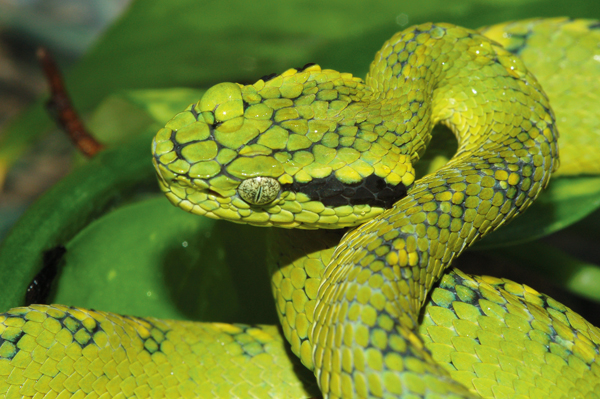Mexican Palm Pit Viper is a species of pit viper, a venomous snake in the subfamily Crotalinae of the family Viperidae. The species is endemic to Mexico. There are no subspecies that are recognized as being valid.
Middle America—the area connecting North and South America that stretches from Mexico through Panama—is a geologically complex region. Characterized by lowlands near the coasts and mountain ranges that form a discontinuous backbone, the region supports an intricate mix of ecological zones. As one travels in elevation in the mountainous areas, temperatures begin to decrease and precipitation is often the rule. Low cloud banks hover over these elevated areas, creating frequent mist that bathes the vegetation. Epiphytes such as bromeliads and orchids flourish due to the high relative humidity, and mosses, ferns and palms are bountiful. Within this “cloud forest” habitat the view is seldom clear as the mist constantly wisps through the trees.
A number of reptile species occur in this unique realm, and possibly the most interesting are the arboreal venomous snakes known as the palm pit vipers. Nine of the 10 known pit viper species of the Bothriechis genus are adapted to these mountainous regions; areas that while considered tropical experience somewhat cooler temperatures than the surrounding lowlands. Relatively small (2 to 3 feet) and slender, palm pit vipers are often observed among low-lying palms, hence the name.
| Kingdom | Animalia |
| Phylum | Chordata |
| Class | Reptilia |
| Order | Squamata |
| Family | Viperidae |
| Genus | Bothriechis |
| Species | B. rowleyi |
| Suborder | Serpentes |
| Binomial Name | Bothriechis rowleyi |

Habitat:
The Mexican Palm Pit Viper is generally found in lower montane forest (850 to 2,100 meters), but has also been recorded at elevations nearing 2,800 meters. The specific name of lateralis refers to the yellow stripe on the snake’s lower green dorsum. Ranging from Panama to Costa Rica, undocumented reports suggest it may also occur in southern Nicaragua. Frequently found near streams, this species appears able to survive to a certain extent in cultivated areas, such as coffee plantations, where it feeds upon lizards and mammals. Like several other palm pit viper species, young side-striped palm pit vipers go through an ontogenetic color change as they mature. It has been observed that the brown juveniles are found closer to the forest floor than the green adults, which are usually encountered in leafy vegetation.
Diet:
All snakes are carnivorous; they usually eat mammals such as rodents but will also take other prey such as lizards, frogs, and small birds. Using the heat-sensing pits located between its eyes and nostrils, this ambush hunter waits until prey comes into striking range. After a successful strike, during which the viper delivers a dose of venom, the snake releases its prey and waits for the venom to take effect. Once it does, the snake then swallows its victim, whole and head first. Following a substantial meal, many snakes may go several weeks or even months between feeding.
Most vipers are ovoviviparous, or “live-bearers,” which means that during reproduction, females retain the developing eggs in their body until they hatch. If all goes well, the female gives birth to 2-20 live young, which are roughly 6-7 inches long and appear physically similar to adults.

Comments
Post a Comment